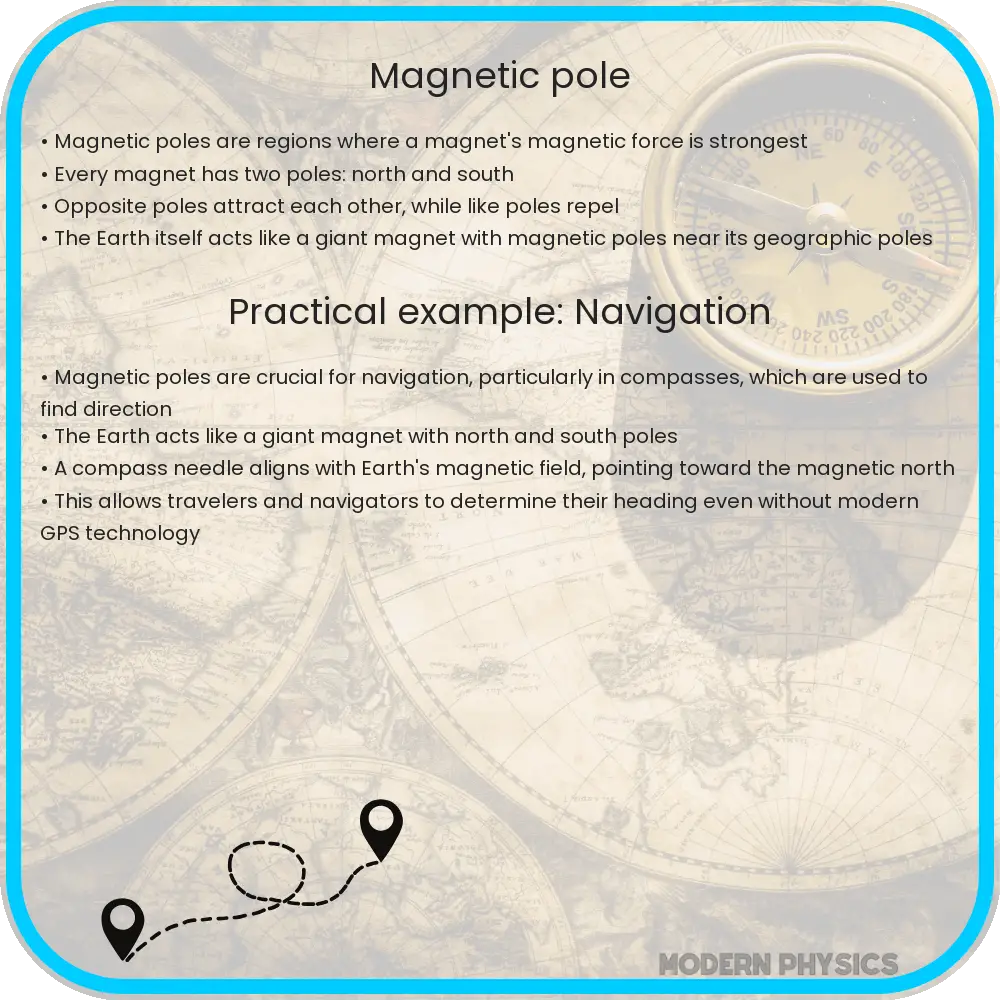Explore the mysteries of Earth’s magnetic poles, their movement, impact on navigation, wildlife, and technology, and the intriguing phenomenon of pole reversal.

Magnetic Poles: Understanding the Basics
The Earth’s magnetic field, an invisible force that extends from the planet’s interior into space, is a fascinating and complex natural phenomenon. At the heart of this field are the magnetic poles, North and South, which play a crucial role in navigation, communication, and Earth’s overall geomagnetic environment.
Theory Behind Magnetic Poles
The theory of geomagnetism explains that Earth’s magnetic field resembles that produced by a giant bar magnet tilted at an angle of about 11 degrees from the axis of Earth’s rotation. This geomagnetic field is believed to be generated by the movement of molten iron and other metals in the Earth’s outer core, a process known as the geodynamo. The locations where the field lines emerge and re-enter the Earth are the magnetic North and South poles, respectively.
Characteristics of Magnetic Poles
Magnetic poles are not fixed and have been observed to wander. The North Magnetic Pole, for instance, has been moving northwestward at a rate of about 10 kilometers per year. This movement is attributed to changes in the Earth’s core. Furthermore, the strength of the magnetic field is not uniform across the planet, varying in intensity from one location to another.
Applications of Magnetic Poles
Magnetic poles have numerous applications in modern society. They are fundamental in navigation, particularly in compass-based systems where the needle aligns with the Earth’s magnetic field. In telecommunications and satellite operations, understanding the Earth’s magnetic field is crucial for signal transmission and interference mitigation.
Magnetic Pole Reversal
One of the most intriguing aspects of Earth’s magnetic field is its ability to reverse polarity. Scientific evidence indicates that these reversals, where the North and South magnetic poles swap places, have occurred throughout Earth’s history, though the process and frequency remain subjects of ongoing research.
Impact on Wildlife and Environment
The Earth’s magnetic field also significantly impacts wildlife, particularly migratory species like birds and sea turtles, which rely on geomagnetic cues for navigation. Environmental effects include the shielding of harmful solar radiation, particularly in the region of the magnetosphere, which plays a critical role in protecting life on Earth.
Technological Implications of Earth’s Magnetic Field
The study of Earth’s magnetic field extends far beyond its natural phenomena, impacting various technological aspects. For instance, geomagnetic storms, caused by solar activity, can disrupt power grids and communication networks. Understanding magnetic poles helps in mitigating these risks. Additionally, advancements in magnetic navigation have led to the development of sophisticated technologies like the Global Positioning System (GPS).
Magnetic Fields in Medicine and Industry
In medicine, magnetic fields have found significant applications, notably in Magnetic Resonance Imaging (MRI). In industrial settings, magnetic materials and principles are employed in a myriad of ways, from electric motors to magnetic storage media.
Environmental Concerns and Magnetic Fields
Environmental scientists also monitor changes in the Earth’s magnetic field to understand and predict climate patterns and geological activities. The interactions between the solar wind and Earth’s magnetosphere, for instance, have implications for understanding the dynamics of Earth’s climate system.
Educational Importance of Magnetic Pole Studies
Educationally, the study of magnetic poles and geomagnetism provides a practical application of physics and earth sciences, fostering a deeper understanding of the planet’s physical properties and processes. It also sparks interest in STEM fields among young learners.
Future Research and Exploration
Future research in geomagnetism promises new discoveries, particularly with advancements in satellite technology and deep-Earth exploration. These efforts may unveil more about the dynamics of Earth’s core, the behavior of magnetic fields, and their broader impacts on space weather and environmental systems.
Conclusion
In conclusion, the study of Earth’s magnetic poles is a multidisciplinary field that offers invaluable insights into our planet’s workings. From aiding in navigation to influencing wildlife behavior and protecting against solar radiation, the magnetic field is a fundamental aspect of Earth’s environment. Understanding its dynamics and implications not only helps in mitigating risks associated with geomagnetic storms but also fuels technological innovations and scientific curiosity. As research continues to unfold the mysteries of Earth’s magnetic behavior, we can anticipate a deeper understanding of our planet and its interaction with the cosmos.
